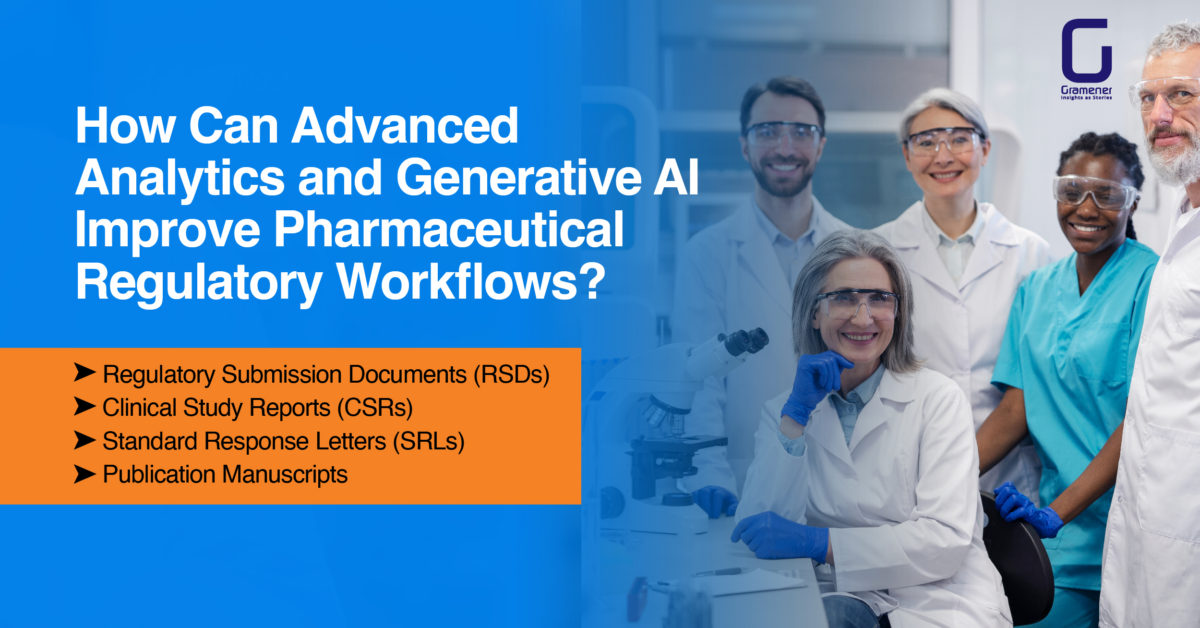For the past few weeks, we have been working with several pharmaceutical organizations to design solutions incorporating generative AI into our existing offerings across the R&D and commercial Pharma value chains. One of the focus areas from these discussions has been various regulatory workflows, working with documents for both internal consumption within the company and then sharing it with external stakeholders including HCPs and regulatory authorities. Here is what we have learned:
Table of Contents
Introduction
As a technology partner specializing in advanced analytics and generative AI solutions for the pharmaceutical industry, we at Gramener understand that accurate and timely documentation is critical for the success of pharmaceutical products. However, creating Regulatory documents (including Submission Documents (RSDs), Clinical Study Reports (CSRs), Standard Response Letters (SRLs), and Publication Manuscripts) can be time-consuming, prone to human error, and lack standardization, resulting in inconsistency in language, tone, and formatting. This also leads to multiple reviews to align with regulatory guidelines.
Watch our on-demand webinar on GenAI and Pharma here.
To address these challenges, we are developing advanced analytics and generative AI solutions that can significantly improve the efficiency and accuracy of this documentation process. At Gramener, we have projects across various maturity levels, starting from design to production through pilots, and we wanted to give you a sneak peek under the hood of our work for complex documentation needs using Generative AI in a customized and efficient manner.
Regulatory Documents And Some Key Examples
Throughout the lifecycle of a drug, various documents are created for regulatory compliance, both internally and externally (regulatory submissions). Various global, regional, and national regulations by health authorities guide these documents. The details and complexities of these documents require a thorough understanding of the regulatory requirements, coordination with various contributors within the company, and working with reviews and comments received both internally and externally. We will look at four such examples-
Regulatory Submission Documents (RSDs)
These documents, such as clinical trial protocols and Informed Consent Forms, are required during clinical trials and run into 100s of pages of complicated text from various internal sources and need to be aligned with regulatory guidelines. These documents also need updates (in many cases annually), adding to the workflow burden for the teams. Generative AI models can automate data extraction and report writing for RSDs, reducing the time needed from 6-24 months to just a few weeks. Gramener’s human-in-loop approach ensures that any output generated by the AI is reviewed and validated by a human expert, resulting in faster turnaround times, reduced human error, improved data accuracy, and scalability.
Clinical Study Reports (CSRs)
CSRs are generated at the end of a clinical trial and collate data from various sources, including statistical outputs and patient case narratives. By automating data extraction and report writing, generative AI models can reduce the time needed to draft CSRs from 3-4 months to just a few weeks. The human-in-loop approach ensures that any output generated by the AI is reviewed and validated by a human expert, reducing the risk of error or bias in the final report.
One of our solutions, AInonymize, is specifically designed to simplify and streamline the clinical trial report submission process, ensuring compliance with complex data privacy regulations. AIaonymize helps meet regulatory requirements by health authorities like the European Medical Agency and Health Canada for disclosing data for submissions that have to balance between transparency & privacy.
Standard Response Letters (SRLs)
Throughout a drug’s lifecycle, various stakeholders, including regulators and HCPs, make inquiries or request additional information. The responses to such requests often require input from various departments within the company, including regulatory affairs, clinical research, safety, and medical affairs. With our advanced analytics and generative AI solutions, regulatory affairs teams can draft responses more quickly and consistently, with less risk of error due to manual review. Our solution ensures that any output generated by the AI is reviewed and validated by a human expert, ensuring consistent tone and language across all letters and handling complex queries accurately.
Publication Manuscripts
Manuscripts typically report on clinical trial results, post-marketing studies, or other research findings relevant to the drug. A typical scientific manuscript can range from around 10 to 30 pages, including the main text, references, figures, and tables. Generative AI models can automate data extraction, literature review, and report writing for publication manuals, reducing the time needed from 6-18 months to just a few weeks.
Gramener’s Human-In-Loop Approach
Central to our service offering is the ‘human-in-loop’ paradigm. Recognizing the inherent risks and subtleties associated with the deployment of Generative AI in a field as nuanced as pharmaceuticals, we have designed technology solutions to complement human expertise. This integration ensures that the final deliverables are not only technologically advanced and innovative but also adhere to the highest standards of reliability and regulatory compliance. Our human-in-loop approach ensures that any output generated by the AI is reviewed and validated by a human expert, ensuring consistency in tone, language, and formatting, as well as reducing human error and improving data accuracy. Most importantly, in early experiments, we have seen that It mitigates the risk of data misinterpretation, ensures the consistency and currency of information, navigates complex regulatory landscapes effectively, and reduces publication biases.
The Gramener Advantage
Gramener focuses on the iterative development of advanced analytics and Generative AI tools. This collaborative development phase is instrumental in fine-tuning offerings to align seamlessly with the bespoke needs of our partners. With proper implementation and oversight, our advanced analytics and generative AI solutions can help you reduce costs, increase efficiency, and improve the overall quality of your work, all while maintaining regulatory compliance and scientific integrity.


